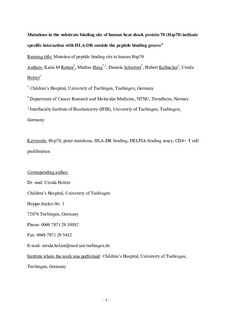| dc.contributor.author | Rohrer, Karin | |
| dc.contributor.author | Haug, Markus | |
| dc.contributor.author | Schwoerer, Daniela | |
| dc.contributor.author | Kalbacher, Hubert | |
| dc.contributor.author | Holzer, Ursula | |
| dc.date.accessioned | 2017-09-26T06:58:07Z | |
| dc.date.available | 2017-09-26T06:58:07Z | |
| dc.date.created | 2014-05-20T12:48:04Z | |
| dc.date.issued | 2014 | |
| dc.identifier.citation | Immunology. 2014, 142 (2), 237-247. | nb_NO |
| dc.identifier.issn | 0019-2805 | |
| dc.identifier.uri | http://hdl.handle.net/11250/2456634 | |
| dc.description.abstract | Heat-shock protein 70 (Hsp70)–peptide complexes are involved in MHC class I- and II-restricted antigen presentation, enabling enhanced activation of T cells. As shown previously, mammalian cytosolic Hsp70 (Hsc70) molecules interact specifically with HLA-DR molecules. This interaction might be of significance as Hsp70 molecules could transfer bound antigenic peptides in a ternary complex into the binding groove of HLA-DR molecules. The present study provides new insights into the distinct interaction of Hsp70 with HLA-DR molecules. Using a quantitative binding assay, it could be demonstrated that a point mutation of amino acids alanine 406 and valine 438 in the substrate binding pocket led to reduced peptide binding compared with the wild-type Hsp70 whereas HLA-DR binding remains unaffected. The removal of the C-terminal lid neither altered the substrate binding capacity nor the Hsp70 binding characteristics to HLA-DR. A truncated variant lacking the nucleotide binding domain showed no binding interactions with HLA-DR. Furthermore, the truncated ATPase subunit of constitutively expressed Hsc70 revealed similar binding affinities to HLA-DR compared with the complete Hsc70. Hence, it can be assumed that the Hsp70–HLA-DR interaction takes place outside the peptide binding groove and is attributed to the ATPase domain of HSP70 molecules. The Hsp70-chaperoned peptides might thereby be directly transferred into the binding groove of HLA-DR, so enabling enhanced presentation of the peptide on antigen-presenting cells and leading to an improved proliferation of responding T cells as shown previously. | nb_NO |
| dc.language.iso | eng | nb_NO |
| dc.publisher | Wiley | nb_NO |
| dc.title | Mutations in the substrate binding site of human heat-shock protein 70 indicate specific interaction with HLA-DR outside the peptide binding groove | nb_NO |
| dc.type | Journal article | nb_NO |
| dc.type | Peer reviewed | nb_NO |
| dc.description.version | submittedVersion | nb_NO |
| dc.source.pagenumber | 237-247 | nb_NO |
| dc.source.volume | 142 | nb_NO |
| dc.source.journal | Immunology | nb_NO |
| dc.source.issue | 2 | nb_NO |
| dc.identifier.doi | 10.1111/imm.12249 | |
| dc.identifier.cristin | 1133658 | |
| dc.relation.project | Norges forskningsråd: 223255 | nb_NO |
| dc.description.localcode | This is the pre-peer reviewed version of the following article:Mutations in the substrate binding site of human heat-shock protein 70 indicate specific interaction with HLA-DR outside the peptide binding groove, which has been published in final form at http://onlinelibrary.wiley.com/doi/10.1111/imm.12249/abstract. This article may be used for non-commercial purposes in accordance with Wiley Terms and Conditions for Self-Archiving | nb_NO |
| cristin.unitcode | 194,65,15,0 | |
| cristin.unitcode | 194,65,15,30 | |
| cristin.unitname | Institutt for kreftforskning og molekylær medisin | |
| cristin.unitname | Centre of Molecular Inflammation Research (SFF-CEMIR) | |
| cristin.ispublished | true | |
| cristin.fulltext | original | |
| cristin.fulltext | preprint | |
| cristin.qualitycode | 1 | |
